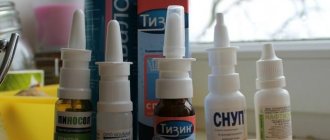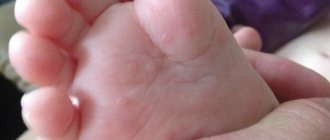Boils in newborns are not uncommon. If this disease is detected, you need to urgently seek help from doctors. The main thing is that the new mother should not be nervous, since there is a risk that the milk will disappear. What is a boil? A furuncle is a formation on the skin of a purulent-inflammatory nature. This inflammation affects the hair follicle and the skin around it. Externally, this process looks like redness on the body and subsequently the formation of a pustular core in the center of the boil. Inflammation is accompanied by very painful sensations. One of the consequences of the formation of a boil is intoxication of the body. The child may experience headaches, fever, and even muscle aches. The baby begins to be capricious a lot and sleeps very little. Why does a newborn develop a boil? Boils often appear due to poor skin hygiene. Another reason is a local or general decrease in human immunity. But boils can still make themselves felt even with sufficient and proper care for the baby. The reason is that the child has not yet developed perfect immunity; the body is not able to protect the baby from microbes that are quite familiar to an adult. This also affects the methods of infection: inflammation upon contact can be transmitted from an adult to a child. They provoke the appearance of boils and staphylococci. If the child is generally healthy, then a boil will not be a serious problem for him. But you should not allow the infection to continue – this can seriously affect the baby’s body and cause a serious illness. A boil appears not only as a separate inflammatory process, but also as an accompanying phenomenon for other diseases: diabetes mellitus, congenital immunodeficiency (when the necessary antibodies are not transferred to the child from the mother), pemphigus of the newborn, and so on. Occasionally, a boil becomes a reaction of the body to various hormonal drugs. How to treat a boil in a baby? Treatment of a boil in an infant is no different from the therapy prescribed for an adult. Since it is almost impossible to force a child to take a pill, children are prescribed injections. If the boil does not affect the general condition of the newborn, treatment begins with local treatment of the source of inflammation. In some cases, boils open on their own, without medical intervention. Doctors advise treating the boil with an antiseptic and prescribing antibacterial compresses based on ointments. The source of inflammation cannot be treated with iodine, as there is a risk of a burn on the child’s skin. In addition, iodine often causes an allergic reaction in infants.
If the boil does not open on its own and does not go away, doctors open it. Under no circumstances should you open a child’s abscess yourself. If not handled correctly, it can cause the pus to break through and enter the body. One possible consequence is sepsis. This is a very serious complication from various purulent diseases and infectious diseases. Sepsis is characterized by the presence of a microbe in the blood and contamination of all tissues and organs of the body. If this happens to a baby, the situation often leads to death. Prevention of furunculosis in newborns There are several simple rules that must be followed in order to prevent the appearance of boils in infants. Before holding a baby, anyone should wash their hands well with soap. Your child’s underwear needs to be changed every day, and after washing, be sure to iron it on both sides. Since every person’s mouth contains a huge number of different microbes, kissing your baby from head to toe is also not worth it. If you use foam, shampoo or baby soap while bathing your baby, then after all procedures you need to lubricate the skin with baby cream. source: mamapedia.com.ua
A boil is a purulent inflammation that can appear on any part of the skin; it is also popularly called a boil.
Furunculosis is a fairly common disease caused by staphylococci. This disease not only worsens the appearance, but also indicates internal problems of the body.
Photo 2 - Furunculosis in a child
Symptoms of furunculosis:
- the appearance of boils on any part of the body; Photo 3 - Furuncle on the face
- increase in temperature (from low to high); Photo 4 - Possible increase in temperature
- deterioration of health; Photo 5 - The child feels weak
- weakness (the child often rests during games, sleeps for a long time); Photo 6 - The child often rests while playing
- lymphadenitis (enlargement of nearby lymph nodes); Photo 7 - Enlarged lymph nodes
- headache; Photo 8 - The child complains of a headache
- decreased appetite; Photo 9 - The child does not eat well
- signs of intoxication may appear. Photo 10 - Possible intoxication
At the initial stage, you can detect a pustule, which causes pain when pressed; gradually it begins to thicken along with the surrounding tissue. At the second stage, the hair follicle begins to fester, then the necrotic tissue is rejected and the wound heals.
Photo 11 - Painful pustule appears first
Attention! If the wound is deep enough, visible scarring may remain on the skin for life. To prevent this, you should pay attention to any complaints of the child and regularly examine the body for any abnormalities.
As mentioned earlier, boils can affect any part of the body and they can cause a lot of discomfort to their owner. Well, how can a child calmly sit at his desk and learn his homework if he has a boil on his butt?
Even more trouble is guaranteed if it is on the face: in the nose, on the lip, on the eye or under the eye. The appearance of a boil in the throat can cause difficulty breathing or swallowing food. The most painful boil is considered to be in the ear, and the most difficult to detect is on the head.
Boils can occur both on rough skin (on the leg, on the knee, on the back) and on soft skin (under the armpit or on the foreskin). In any case, treatment should be started immediately when the first signs of the disease appear.
Photo 13 - Boil on the face Photo 14 - Boil in the nose Photo 15 - Boil on the lip Photo 16 - Boil in the ear
Important! The risk group includes areas such as the nasolabial triangle, neck, genitals and natural folds (groin, armpits, intergluteal area).
Even a small child who has just been born can develop an unwanted abscess. A child under one year old is admitted to hospital and treated in a hospital. Parents can take children who are already 2 or 3 years old home and carry out the treatment themselves.
Photo 17 - Children under one year of age are treated in hospital Causes of boils in a child
To avoid the appearance of boils, you need to know what causes ulcers and carry out appropriate prevention. Staphylococci, which provoke their appearance, surround the child everywhere, and for successful development they only need weak immunity.
There are several factors that influence it:
- constant damage to the skin (for example, frequent wearing of too tight, chafing clothes); Photo 19 - It is important to immediately heal wounds on the skin
- poor hygiene (wearing diapers for a long time or irregular bathing); Photo 20 - The child must maintain hygiene
- poor nutrition (lack of minerals, trace elements and vitamins); Photo 21 - Monitor your child’s proper nutrition
- diseases of the endocrine and nervous systems; Photo 22 - Check the child’s endocrine and nervous system
- immunodeficiency. Photo 23 - Give your child vitamins
To strengthen the immune system, doctors advise giving the child more vitamins; rosehip decoction or citrus fruits can be used as a source.
Parents should pay more attention to hygiene: whether bathing is frequent enough, whether hands are washed thoroughly before eating. If the skin has been damaged, the injuries need to be disinfected.
Is furunculosis contagious and is it possible to attend kindergarten? The child’s immunity is reduced during this period, and kindergarten will be another test for him, so it is better to let the body fully recover.
Photo 25 - Do not take your child to kindergarten until complete recovery
Treatment of boils in a child:
What to do when an abscess appears, how to treat furunculosis and which doctor can help with this?
Attention! There is no need to press, cut, pierce boils in children or perform other manipulations with them, this can lead to complications, including blockage of blood clots, inflammation of the lymph nodes, fatty tissues, adjacent tissues, etc. In this case, a hospital is prescribed.
First of all, we go with the child to the dermatologist. Only a qualified doctor can tell you how to cure a boil. It depends on the stage at which the abscess is located.
At the initial stage, ultraviolet treatment is carried out, and at the maturation stage, antibiotics are prescribed. A specialist will tell you how to treat furunculosis and how to get rid of it forever.
What laboratory tests can a doctor order?
- General blood and urine analysis.
- X-ray of the lungs and paranasal sinuses.
- Blood culture for sterility.
- Nasopharyngeal culture for staphylococcus.
- Biochemistry of blood.
- Study of immunological status. Photo 28 - Tests will help find the cause of boils
Don’t be intimidated by the large number of tests; all this is necessary not only to cure the boil, but to find its root cause and get rid of the hated disease forever.
If the boil is deep, then antibiotic injections into the affected area are usually prescribed. In simpler cases, ichthyol ointment is suitable. After the abscess has opened, you can anoint it with peroxide to speed up healing and prevent infection.
In later stages, surgery may be required. The doctor will cut the affected area, remove the rod, and sterile dressings will be applied for several days until the child is completely healed.
After treating a boil it is very important:
- take vitamins;
- maintain a daily routine;
- go for a walk more often;
- maintain personal hygiene.
Furuncle in a newborn
The worst thing for young parents is when a boil appears in an infant. The baby still has a very weak immune system, not accustomed to all environmental irritants, so young children need to be looked after especially carefully: bathe them, change diapers on time, continue breastfeeding if possible, and examine the child’s body.
It is easy to notice a boil on the butt, stomach or back, but you also need to look in the ear, on the head and other parts of the body. The causes of furunculosis in infants are the same as in older children, but treatment requires greater responsibility, so it is carried out exclusively in a hospital under the constant supervision of doctors. If neglected, there is a risk of developing dangerous complications, including meningitis.
Photo 32 - Examine the child daily
Attention! Treatment with traditional methods in childhood is extremely undesirable; this can only further aggravate the problem. It is also not recommended to try to independently remove the rod from a one-year-old child. If the abscess has not yet matured, the rod will rupture and treatment will take a long time.
Photo 33 - Newborns are treated only in a hospital
For minor skin lesions, the doctor may allow you to treat a 3-month-old baby at home. Since this is too young an age to take antibiotics orally, they are used externally.
To do this, wash the boil and apply an antibiotic prescribed by the doctor. For faster maturation of the abscess, it is recommended to apply warm compresses.
After treatment, parents must wash their hands with soap and water, as well as wash the baby’s bedding and clothes.
source: udermis.ru
The presence of a boil in a newborn is not as rare as it might seem at first glance. Of course, frightened mothers immediately seek help, but until this moment they lose a lot of nerves.
What causes the disease
An abscess can appear on the stomach, back, arms, groin - on any part of the body that has hair follicles. The most dangerous location of boils is on the head and neck.
If a boil is found in the ear, nose, eye or lip, you need to be treated immediately; complications can be very serious.
The causative agents of the pathology are opportunistic microorganisms - Staphylococcus aureus bacteria. They are part of the normal microflora, but under the influence of certain negative factors they are activated, their numbers are rapidly growing, and as a result of this vital activity, suppuration is formed.
So what are the reasons for the appearance of such a dangerous neoplasm? Scientists have identified many factors that can provoke the disease:
- skin injuries - through them the infection gets inside;
- lack of proper, regular hygiene;
- dysfunction of metabolic processes;
- the presence of endocrine diseases;
- chronic or acute infections;
- hypothermia or, on the contrary, overheating;
- abuse of steroid drugs;
- poor nutrition.
Most often, infection in children occurs due to scratching the skin with unwashed hands, but not all children develop boils as a result of this. All of the above reasons can provoke an illness only against the background of reduced immunity; in this case, the body is simply not able to cope with the infection on its own, and therefore the child develops a boil.
It is better to avoid self-medication; at the first symptoms of suppuration, consult a doctor.
Causes of boils
The skin has a lot of sebaceous, sweat glands, and hair follicles. Hair follicles are surrounded by subcutaneous fatty tissue. If an infection gets into the skin, then the development of an acute inflammatory process begins, which is expressed as a boil. If a boil appears not in one, but in many places, then this process is called furunculosis. A boil can occur in parallel with diseases such as hypovitaminosis, diseases of the digestive system, diabetes, malnutrition, a weakened immune system, and frequent hypothermia.
Signs and stages
Without knowing how a boil develops, it can easily be confused with an ordinary pimple. In this case, parents do not carry out treatment, exposing the baby to the risk of all sorts of complications.
You can recognize a boil in children by the following signs:
- a future boil always forms around the hair follicle;
- the localization site is red and painful;
- upon palpation, a rather dense node (infiltrate) is felt;
- possible increase in temperature (up to 38-39 degrees);
- the affected area itches and a tingling sensation is felt.
These are common symptoms of the initial stage of the disease (infiltrative), which cannot be ignored. Next comes the second stage of development of the boil - purulent-necrotic masses are formed:
- inflammation spreads to surrounding tissues, sebaceous glands;
- the size of the abscess increases and can reach 5 cm;
- yellow-green masses are visible in the center of the pustule;
- melting of the boil tissue is observed - fistula openings appear.
Such symptoms indicate that the boil is ready for self-cleaning - this is the third stage - opening of the abscess and its healing:
- the thin skin on the surface of the boil bursts;
- purulent exudate comes out;
- Inside the opened ulcer, necrotic masses (the core of the abscess) are visible - do not try to squeeze it out, it will come off on its own.
After cleansing, the cavity is filled with granulations - the wound healing process begins. At first, the affected tissues acquire a purplish-blue tint, but over time they lighten, leaving an inconspicuous scar.
From the appearance of the first symptoms to the opening of a boil in a child (as well as in an adult), 7-10 days pass, sometimes longer.
A boil must necessarily go through all three stages of development - infiltrative, purulent and restorative. Never open an abscess yourself, especially prematurely, the consequences can be disastrous.
Main symptoms
What does a boil look like? When such an abscess develops on the leg, the skin begins to turn red, itch and itch. Then local pain occurs. This creates a boil that looks like a large pimple. It is diagnosed quite easily. As the abscess develops, the affected area begins to twitch. Many patients experience a noticeable pulsation, which stops after the boil matures.
If such a problem occurs in the area between the legs, then it causes a lot of painful sensations. This is due to constant friction of the abscess when walking.
Possible complications
Without adequate treatment, a pathological abscess can provoke serious complications, especially when the boil is localized in the nasolabial triangle, neck, eye, or ear canal.
With this location, the infection from the boil can penetrate the bloodstream and spread to the brain, causing meningitis, sepsis or other pathologies often resulting in death. If treatment is untimely or inadequate, the following complications are possible - thrombosis, abscess, phlebitis, pyelonephritis, erysipelas, lymphadenitis.
When localized to the eye, the disease can lead to loss of vision. An abscess located in the ear can deprive the baby of hearing. In addition, advanced pathology often develops into a chronic disease with extensive skin damage. It is quite difficult to treat furunculosis in children; the disease is prone to frequent relapses and the spread of infection to internal organs.
To avoid negative consequences, it is necessary to consult a doctor in time and undergo the treatment prescribed by him.
Why is a boil dangerous?
A boil is a consequence of an infection caused by microorganisms. Therefore, it is important to carry out timely treatment to avoid complications. Dangerous consequences include:
- The appearance of thrombosis.
- The disease is pyelonephritis.
- Development of phlebitis.
- Infection with purulent meningitis.
The infection can spread to nearby organs and also cause blood poisoning. This can lead to serious complications and in some cases death.
Diagnostics
Usually, to make a diagnosis, it is enough for a doctor to examine the patient, but in some cases laboratory and instrumental studies are performed.
So, in severe cases of the disease, a CT or MRI, ultrasound are performed, and the following is performed:
- biochemical analysis of blood, urine;
- bacterial culture of the contents of the pustule;
- dermoscopic examination.
Sometimes a small patient requires additional examination by specialists with a narrow focus - for example, if a boil is localized on the eye, a consultation with an ophthalmologist is needed. Based on the results obtained, treatment is prescribed.
Diagnostic measures
They are carried out to determine the causes of boils and separate them from diseases accompanied by similar symptoms. Common research methods include:
Diagnostic measures are carried out to determine the causes of boils
- initial examination and collection of the baby’s medical history;
- urine and blood analysis;
- dermatoscopy;
- analysis for bacterial microflora (bacterial culture);
- photo of the lungs;
- Ultrasound.
For a boil in adolescents located in a hard-to-reach place, they may additionally prescribe an MRI or CT scan or perform a spinal tap. In childhood, a consultation with a dermatologist is not the only one - in parallel with it, a visit to an ophthalmologist, surgeon, pediatrician, etc. may be prescribed.
Traditional therapy
The doctor will determine how to treat the boil based on the severity of the disease. In an uncomplicated form of the disease (a single boil), no specific therapy is required - the main thing is to wait for the abscess to spontaneously open, and then treat the wound with an antiseptic solution (furacilin, hydrogen peroxide, iodine).
You can speed up the process of maturation of the abscess by applying Vishnevsky or Ichthyol ointment, Shostakovsky balm and other drugs that draw out pus to the site of the lesion. Such manipulations will shorten the period of illness by several days.
If an already mature boil cannot break through on its own, the doctor pierces a thin layer of skin on its surface and releases the pathogenic exudate out. If the neoplasm is large, silicone drainage is introduced into its cavity, which improves the outflow of contents. After 2-3 days, the wound is disinfected and a bandage is applied with antibacterial ointment (Levomekol, Fucidin, Bactroban, others). To avoid complications, follow all recommendations of your doctor.
Treatment of chronic furunculosis is carried out with systemic antibiotics. Immunomodulatory medications and vitamins are also prescribed.
In addition, it is necessary to treat concomitant pathologies.
- Antibiotics. If the abscess is deeply localized, the affected area is injected with antibacterial drugs - this will prevent further spread of the infection and reverse the pathological process. In case of multiple contamination, medications are taken orally or administered intramuscularly (Azithromycin, Sumamed, Ceftriaxone).
- Vitamin therapy. Most often, children are prescribed oral intake of vitamins A, B1, B2, C, PP, but intramuscular administration may also be recommended.
- Immunomodulators. Drugs that stimulate the immune system are taken strictly according to the regimen prescribed by the doctor (Interferon, Myelopid, Seramil).
In addition, physiotherapy (Ural irradiation, UHF, laser treatment) can be used for therapeutic purposes. In case of deep abscesses, surgical opening of the abscess can be performed, since the risk of an abscess breaking into the anatomical cavities in this case increases.
How to treat a boil in a child at home?
The skin of a child is characterized by increased sensitivity to the effects of various types of unfavorable factors, both external and internal. That is why the appearance of all kinds of irritations , acne and other formations on children's skin is a fairly common occurrence.
In most cases, this situation does not cause concern, but if the baby develops a large purulent boil , this is a reason to consult a doctor as soon as possible.
If a child’s boils are multiple in nature, we are talking about a serious disease – furunculosis. This condition is very dangerous and can cause significant harm to the health of the baby.
Therefore, the baby requires qualified medical care. And before starting treatment, it is necessary to establish the cause that provoked the occurrence of this problem and eliminate it. Only in this case will the therapy be correct and complete.
What to do if a child has flux? Find out the answer right now.
General information
A boil is a large pustular formation . A boil forms around the hair follicle, damaging not only it, but also the surrounding tissues (sebaceous glands and connective tissue).
The causative agent of the disease is most often Staphylococcus aureus, however, other pyogenic bacteria can also lead to the development of furunculosis.
If the bacterial infection of the body is widespread , numerous purulent formations – boils – appear on the child’s skin. In this case we are talking about a dangerous disease - furunculosis.
This pathology is considered not only as a cosmetic defect, although large boils, especially if they are located on open areas of the body, do cause a lot of aesthetic inconvenience.
Furunculosis, first of all, is a dangerous disease that causes pain to the child, but can provoke the development of more serious complications, since with furunculosis the integrity of the skin, a natural protective barrier that blocks the path of pathogenic microflora, is disrupted.
Reasons for the development of furunculosis
Numerous unfavorable factors (external or internal) can lead to the occurrence and development of furunculosis in a child.
| External | Domestic |
|
|
Read about the symptoms and treatment of neurodermatitis in a child here.
Kinds
Due to a wide variety of factors and individual characteristics of the child’s body, a wide variety of pustular formations can appear on the baby’s skin.
Therefore, in dermatology it is customary to classify them as follows:
- A furuncle is a single formation that affects only 1 hair follicle.
- A carbuncle is a larger abscess that affects several hair follicles. It is an abscess formed as a result of the merger of several single boils.
- Cystic acne formations . With this form of furunculosis, the deep layers of the epidermis are affected, resulting in a large number of small rashes that can appear on the face and other parts of the body. Most often, teenagers face this problem during puberty.
- The pilonidal sinus is a very large and painful purulent formation that occurs in the area between the buttocks. Most often, this problem is encountered by children who are overweight and lead an inactive lifestyle.
- Hidradenitis suppurativa is a disease that affects the sweat glands. In the damaged areas, multiple large abscesses appear (most often in the armpits, groin area), in which there is no necrotic core.
Damage to the sweat glands is also associated with bacterial infection, however, antibiotic therapy alone is not enough and the child will require surgery to remove the affected sweat gland.
Symptoms and signs
A boil can be recognized by its certain signs, such as:
- The appearance on the skin of a single pustular formation, which has a dense center rising above the surface of healthy skin. The core of the boil gradually forms in this center. The skin around it swells, hyperemia is observed.
- A white head appears in the center of the formation, filled with purulent contents and covered with a thin film.
- The child experiences discomfort, itching, and pain in the affected area.
- A boil can form on almost any part of the body, with the exception of those areas where there are no hair follicles (for example, the skin of the feet and the inner surface of the palms).
- The inflammatory process leads to an increase in the nearby lymph nodes.
- Hyperthermia often appears (up to 39 degrees).
- The child's general well-being is affected.
Purulent formations go through 3 stages of development:
- Infiltration is thickening and redness of the skin affected by a bacterial infection.
- Suppuration - as a result of the destructive activity of pathogenic microflora, intoxication of surrounding tissues occurs, and suppuration occurs. At this stage, the core of the boil is formed.
- Healing – a scar forms on the affected area, swelling and redness gradually disappear.
The process of development and healing of a boil takes an average of 10-12 days, although it all depends on the state of the child’s immune system and the treatment prescribed to him.
Complications and consequences
The most dangerous complication that occurs as a result of improper treatment of furunculosis or lack of therapy is extensive intoxication of the body, which can lead to blood poisoning and, as a consequence, the death of the child.
In medical practice, there are cases where an unsuccessful attempt to independently squeeze out a boil later led to the development of sepsis and death (one such example is the famous composer A. N. Scriabin, who unsuccessfully squeezed out a boil and subsequently died from blood poisoning).
Other dangerous consequences of furunculosis are:
- purulent damage to the brain and other internal organs;
- the formation of blood clots that interfere with the normal outflow of lymph;
- other diseases of the lymphatic system.
Recommendations for the treatment of pityriasis rosea in children can be found on our website.
Treatment options
The main method of treating furunculosis is to use medications , such as:
- Antiseptics for topical use (hydrogen peroxide, brilliant green) are necessary to disinfect tissues.
- Compresses using a sorbent drug that draws out purulent contents from the wound.
- Dressings using antibacterial ointments (Ichthyol, Vishnevsky ointment).
These measures must be carried out in strict sequence, otherwise the treatment will not only have no effect, but may also aggravate the situation.
Folk
Time-tested methods such as:
- Grated potato compress. A small potato should be grated on a fine grater, placed in a gauze bandage and applied to the affected area of the skin until dry.
- Aloe compress. A freshly picked leaf of the plant is crushed, this mass is applied to the boil, and wrapped in a gauze bandage, which must be changed 3 times a day.
Since the cause of furunculosis is a bacterial infection , taking antibiotics is a prerequisite for successful treatment.
Moreover, the child is most often prescribed broad-spectrum drugs that have a detrimental effect on most types of pathogenic microflora.
Other methods
Today, physiotherapy , for example, exposure to a high-frequency magnetic field. One of the most effective ways to combat the disease is laser removal of boils.
What not to do?
If a boil occurs, you should not self-medicate and try to open and clean the wound yourself.
This can lead to more abscesses and more serious consequences (for example, sepsis). In addition, the inflamed area should not be heated, as the inflammatory process in this case will only intensify.
Do I need to open it?
In some cases, it is necessary to open the boil (for example, if we are talking about a very large formation), but this should only be done by an experienced specialist.
For smaller boils, an autopsy is not necessary; you just need to wait and follow all the doctor’s recommendations.
Doctor Komarovsky's opinion
Having noticed a purulent formation on the child’s skin, many parents try to remove it themselves . And this does not always work out successfully.
In many cases, after such treatment, the problem arises again and on an even larger scale.
In addition, removing a boil is not all; you need to find out why it appeared and eliminate this cause. And only a doctor can do this. Only in this case will the treatment be complete.
Prevention
reduce the risk of developing furunculosis if:
- provide the child with proper hygienic care;
- dress the baby in comfortable clothes that do not chafe the skin;
- protect the child from injuries, and if they occur, immediately treat the wound with an antiseptic;
- ensure proper and nutritious nutrition, an active lifestyle;
- identify and treat various diseases in a timely manner.
Furunculosis is an unpleasant and dangerous disease accompanied by damage to the skin.
A furuncle is a purulent formation that affects the hair follicle and the tissues closest to it.
The pathology causes the child a lot of suffering and can cause the development of dangerous life-threatening . Therefore, when the first signs of pathology are detected, it is necessary to begin treatment.
How to treat boils in children at home ? Find out from the video:
We kindly ask you not to self-medicate. Make an appointment with a doctor!
Source: https://pediatrio.ru/f/furunkul/u-rebenka-25.html
Traditional methods
For children, it is permissible to use non-traditional means of treatment only after consulting a doctor. Single boils with an uncomplicated course can be cured using the following recipes from traditional healers:
- applying dry heat (heated salt or egg) to it;
- Baked or boiled onion in milk will draw out the purulent contents - grind it into a paste and apply to the affected area;
- aloe pulp in the form of a compress is applied to the boil and left overnight;
- slightly beaten cabbage leaves - they are tied to the site of the abscess;
- make an ointment from baked onions, brown laundry soap and honey - mix everything in equal proportions and treat the abscess.
All these manipulations will speed up the process of maturation of the abscess. After opening it, be sure to treat the wound with an antiseptic solution or use an infusion of chamomile, calendula, or St. John's wort. You can also use aloe or Kalanchoe juice.
For preventative purposes, promptly treat all wounds and abrasions, treat diseases and instill in your child a love of a healthy lifestyle. Eating a nutritious diet, regular outdoor walks and moderate exercise are useful for strengthening the immune system. All these simple tips will help protect your child from health problems, in particular, avoid furunculosis.
Surgical intervention
In most cases, the formation matures on its own and does not require surgical intervention.
But if maturation is delayed and the child’s condition does not normalize, surgical intervention is indicated.
The doctor administers anesthesia and cuts the boil. The cavity is cleaned of pus and the rod, and then antibacterial ointment is injected into the wound. Apply a gauze bandage.
Next, parents carry out treatment at home, strictly following the doctor’s recommendations.
Furunculosis in the mother
The occurrence of boils in a woman during pregnancy carries a danger not only for her, but also for her unborn baby. This disease significantly reduces immunity, which allows infection to enter the body, causing:
There is a high probability of negative consequences for the child. Furunculosis during pregnancy is especially dangerous in the first trimester of fetal development, when the most important systems and organs of the baby are formed. The inflammatory process is reflected in the development of certain congenital pathologies in the child. Among them:
- heart disease;
- kidney pathologies;
- problems with the central nervous system.
Subsequently, the child may experience delays in mental and physical development. If furunculosis occurs in the mother in the 2nd or 3rd trimester, there is a high probability;
- development of placental insufficiency;
- the occurrence of hypoxia;
- fading pregnancy;
- premature birth.
READ ALSO: Rash on a child’s body: on the arms, legs, stomach, skin
Often, women who have had furunculosis during pregnancy give birth to babies with low weight, meningitis and pneumonia.
Classification
Regardless of its location, every boil that appears on a child’s skin can lead to the most unpleasant consequences. Experts have developed a classification of such inflammations, which characterizes certain signs:
- single, which can be located on any part of the body;
- cystic acne, which occurs on the face of adolescents and occurs in the deep layers of the dermis;
- pilonidal sinus - boils that occur in the intergluteal space due to rubbing of clothing, sweating and physical inactivity;
- hidradenitis suppurativa, which is a large number of recurrent boils, localized in areas of increased sweating (armpits, groin), resulting from inflammation of the sweat glands.











